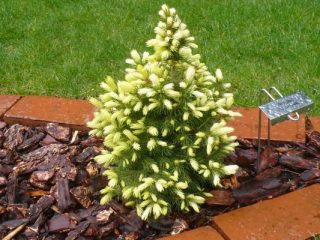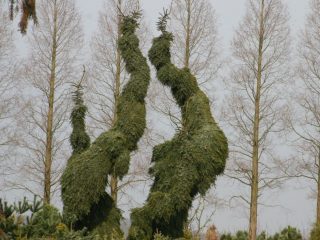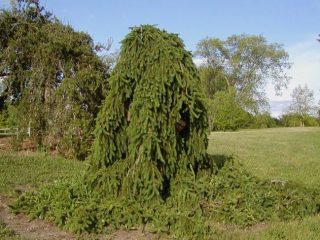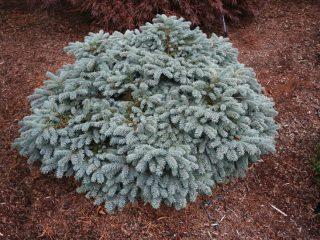Content
Majestic spruce trees are increasingly becoming a basic element of garden and park landscapes. Evergreen trees bring joy both in the faceless, gray autumn and in the monotonous white winter. Inversa spruce is one of the popular varieties of coniferous trees. Agricultural technicians will share information about the rules for planting ornamental crops and caring for them.

Inversa spruce can take the form of a bush or tree with an inconspicuous trunk and a bowed top
History of origin
The Inversa spruce variety was first discovered in Shropshire, England in 1884. This type of coniferous tree was discovered and described by R. Smith, who conducted botanical research in the area. The unusual thing about the weeping spruce was that its shoots grow upwards, not downwards. Gradually, the unique culture became a sought-after element in the design of parks and gardens in continental Europe.
Description of the weeping spruce Inversa
Common spruce Picea abies Inversa – lat. (Pise ebis inversa - inverted common spruce) refers to a weeping tree species.The plant has thick and long needles that remain green all year round. Tender green young spruce trees darken over time. Like most conifers, Inversa belongs to the group of monoecious plants: male and female cones grow on the tree. They differ in color and location. The red-brown female buds look like candles with blunt ends; the male green buds have a purple tint.

The lifespan of the Inversa spruce is 150 years.
Height of Inversa spruce
A young tree grows slowly - by the age of ten it reaches 1 m. The formation of an adult plant noticeably accelerates. Over the course of several years, the size of the spruce tree reaches 5-6 m in height, while its crown width is 2 m. Without pruning, the tree resembles a wind-tumbled haystack, its trunk resembles a branched shrub, and in some specimens the main shoot stands out. The lower legs spread along the ground, the remaining branches are pressed to the central part of the plant.
Winter hardiness zone of Inversa spruce
The Picea abies Inversa variety, growing in temperate climates, is also found in the European part of Russia. In the wild, coniferous trees can be seen both in mixed forests and in spruce forests.
Advantages and disadvantages
The common spruce Inversa Pendula (Picea abies Inversa Pendula) is not a product of selection, it is a natural species. Despite the similarity of the tree with other representatives of the botanical family, the plant has its own characteristics. The main one is the plasticity of the crown, which is formed artificially.

Evergreen needles make the tree popular among landscape designers and garden owners
Pros:
- unpretentiousness and ease of care;
- sufficient level of adaptation to cold weather;
high threshold of pest resistance;
- compact sizes.
Minuses:
- poor tolerance to hot weather;
- predisposition to fungal diseases;
- Mandatory crown pruning, without which the tree does not look aesthetically pleasing.
Planting Inverse spruce
Inverse spruce can be planted in spring or autumn, in cool weather. Agrotechnicians recommend purchasing seedlings with a closed root system, grown in containers, otherwise the young tree will die. The planting site must meet the following requirements:
- be located in a well-lit place;
- be well drained;
- unacceptably close occurrence of groundwater;
- the land should be light and fertile;
- The preferred soil composition is sandy loam or loam.
But the acidity level of the soil for Inverse spruce is not decisive. The tree feels comfortable in both acidic and neutral soils, as well as alkaline soils.
A seedling with a ball of earth 50 cm in diameter is planted in open ground, in a hole half a meter deep with a formed drainage layer. The root collar should not be allowed to deepen. An earthen bank is formed around the tree trunk area, which will not allow water to spread during irrigation.
During planting, nitroammophoska is added to the soil to accelerate the development of the root system. If the soil in the area is heavy, it is necessary to make drainage to prevent stagnation of water. Finally, the seedling is watered with water in an amount of 30-40 liters and the tree trunk circle is mulched with peat.
Caring for Inverse spruce
Inversa, like many coniferous crops, does not tolerate heat well. In hot summers, the tree needs regular, abundant watering. One seedling requires 10-12 liters of water. In the first year, the tree is watered at least once a week.
After rains and watering, the soil is loosened, since compaction of the soil can slow down the adaptation period of the plant. Mulching prevents unwanted moisture loss. Despite the fact that coniferous species are less in need of additional nutrients, they must be fertilized twice a season. Compost and vermicompost are used as fertilizer. Due to the high nitrogen content, it is not recommended to use manure for feeding.
A significant part of the work on caring for the Inversa variety is occupied by the formation of the crown. To make the tree rise up, the largest shoot is tied up, the remaining branches fall to the ground. They need to be pinched, giving the crown the desired shape. After the central shoot reaches the required size, it is cut off, thus stimulating the development of lateral branches. For the winter, the trunk of a young Inversa spruce is covered with peat 5 cm thick and covered with coniferous branches.

Pruning the lower branches of the Inverse spruce prevents the development of fungal infections.
Reproduction methods
Independent propagation of Inverse spruce requires certain skills. Coniferous crops can be propagated by seeds and cuttings:
- the first propagation option allows you to cultivate a high-quality plant with good immunity;
- When cuttings are taken, a tree is obtained that is a copy of the parent form.
In the case of vegetative propagation, layering and cuttings are used. It is advisable to choose shoots that formed two or more seasons ago. At the top of the branch there should be a formed apical bud.
Diseases and pests
Most often, Inverse spruce suffers from fungal infections that develop due to dampness resulting from the contact of the lower branches with the soil. A sign of the disease is a change in the color of the needles. For preventive purposes and to combat fungus, spraying with fungicidal agents or copper sulfate solution is carried out.
Insects rarely damage the Inverse variety. Among the pests that can negatively affect spruce:
- spider mite;
- false scale insect;
- spruce hermes;
- spruce sawyer;
- spruce aphid.
As a preventive measure, agricultural technicians recommend treating plantings with insecticides. During the summer season, at least two spraying procedures must be carried out.

The rich color of the needles and the formation of new shoots indicate that the tree is healthy
Spruce Inversa in garden design
The unusual appearance of Inversa spruce and the ability to create various forms based on the tree make the variety popular with gardeners and specialists in the field of landscape design. Most often, coniferous plants are planted alone or in combination with decorative flowers and shrubs. The tree looks great on an open lawn and can become an accent solution when creating an alpine slide.A popular technique is to graft Inverse spruce onto a standard. This plant resembles a fantastic monster entwined with long algae.
Features of caring for weeping spruce are presented in the video:
Warning! When planting spruce, you should take into account that the tree grows over time. Therefore, it is not recommended to place coniferous crops close to buildings.

Inversa spruce with a weeping crown can decorate a personal plot and a city park
Conclusion
Spruce Inversa is ideal for lovers of everything nontrivial. Despite its exotic appearance, the plant is unpretentious and is also little susceptible to infections and pests. An adult tree tolerates winter cold well, but requires abundant watering in hot summers.








